Rigid String Geometry (2006)
An audiovisual installation by Ludger Hennig and Hanns Holger Rutz. It is based on the work “Installed Piano String” which was developed at the Studio for electroacoustic Music (SeaM) Weimar under the direction of Robin Minard.
The central element of the installation is a long steel string which is used as an electroacoustic instrument—it is stimulated by a body sound transducer and picked up by a piezo microphone. The string originally referred to the work of Franz Liszt who was best known as a piano virtuoso and a revolutionist of the piano playing technique.
Sound…
All sound is taken from the string. a body sound transducer is attached to one end of the string to excite the string. die vibrations are picked up by a piezo microphone on the opposite end. a process is run once a day to analyse the spectrum of the string and to record each resonant frequency. while in theory the spectrum of a string is composed of integer multiples of its fundamental frequency, in the real physical system a lot of different formants and inharmonic frequencies exist. due to the length of the string, the fundamental frequency lies below the audible range and causes harmonics to be very close to each other. the analysis can discriminate around 140 and 150 peak frequencies in the spectrum.
The string is excited with sinusodial impulses at these frequencies and recordings are made. the decay time of a long string is of the order of fifteen seconds and more, so the playback of the recordings in a spatially distributed way must take care of the polyphonic character of overlapping tones. apart from the direct recordings, a set of transformations is applied to the original sounds, including frequency and time distortion, crossmodulation and convolution. during the initial stage of analysis, recording and rendering, which takes around one hour, a recording of the installation from previous days is played back. the installation then switches to realtime composition of the sounds.
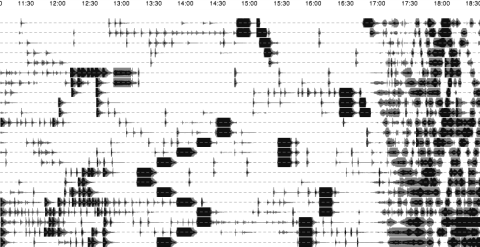
The sound is composed of up to eight simultaneous layers. five types of layers exist with distinct sound characters and spatial configuration:
- [A] think of the speakers as knots in a net. choose two speakers and find all trajectories between these two knots without making detourings. play small glissando gestures of the original sine impulse recordings where each impulse travels along the knots in the path. occasionally increase or decrease the tempo, occasionally insert pauses.
- [B] think of two neighbouring speakers as a horizontal or vertical line. play a percussive metallic variation of the impulses on one of these lines. make a pause. play a similar variation on a line in the opposite side of the room. make a ninty degree rotation and repeat.
- [C] choose spherical sounds computed by convolution. choose around four sounds computed at different days of the week. place these sounds in different random positions of the space and let them move slowly with a slowly varying tempo. movement is continuous through amplitude panorama.
- [D] choose sounds computed by wavelet pyramidal decimation and frequency shifting. choose around four sounds computed at different days of the week. choose between a bright high tempo version and a temporally more coarse-grained version. for each sound choose a random position in space and have the sound jump to a new location upon recognition of a transient impulse.
- [E] play a broadband crackling noise through the transducer onto the string and project the sound picked up by the microphone in the space. one phrase lasts around fifteen or twenty seconds. insert a small pause, play back the recording of the noise picked up by the microphone onto the string, again record the microphone and project its sound. repeat in the fashion of a feedback process. apply a small transposition, high pass filtering and distortion onto the sound in order to keep the feedback process stable and to maintain an overall bright colour. project the sound onto a line of speakers and shift the line in each new iteration.
The sound composition is implemented with SuperCollider and FScape.
Tesla Room Recording
Franz Liszt Museum
permanent installation in weimar since july 2006
In 2005, the university project “Installed Piano String” began to develop a concept for an audiovisual installation in the former apartment of Franz Liszt in Weimar. The house was planned to be opened as the new Franz Liszt Museum in 2006.
While the first floor remains largely untouched and hosts the historical apartment of Liszt, the ground floor was completely renovated using a contemporary museum design. the installation’s steel string acts as a brace between the new and the old part of the house, since it traverses the house vertically from the basement up to the roof top.
The installation room is located in the ground floor. the following photos show the string (protected by a plexiglass tube), wall speakers (twentythree speakers covering all walls and the ceiling), the base plate made of glass—allowing the visitor to look down to the basement where the transducer is mounted—a view of the transducer from the very bottom, the roof top construction and the machine rack comprised of speaker and microphone amplifiers, audio interface and computer.
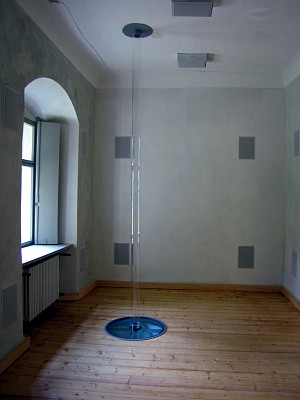
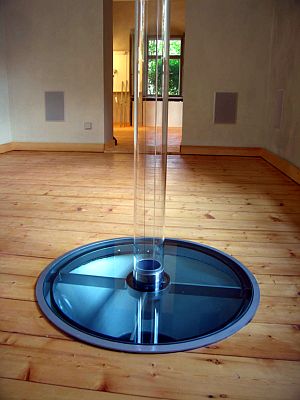
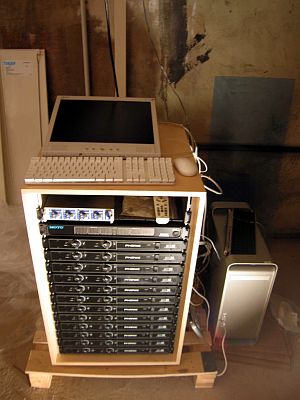
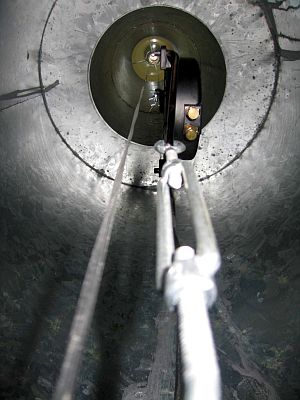
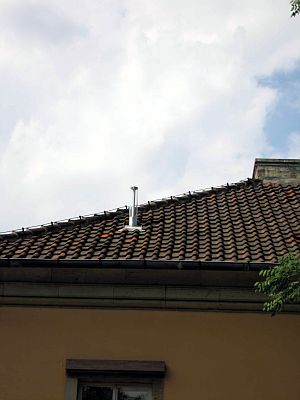
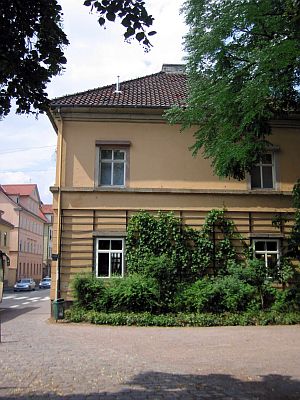
The visual strategy was to not create an immersive black box but instead retain the original organic atmosphere of the room. I developed a video image that was carefully projected onto one wall under daylight conditions, so as to have a kind of negative shadow or the impression of a play of light. What you see is a synthesis of an abstract string-like object («Taufaden»), composed using the software Jitter:
Tesla mit Sonambiente
open studio installation in berlin july 2006
We were invited by Tesla to present the installation in a series of Open Studios during the Sonambiente festival in july 2006. In Tesla’s Studio 2 we were faced with a completely new space and were challenged to develop an appropriate concept for the new context of the installation. The studio space was comparably larger than the original room in the Franz Liszt Museum, lacking the particular atmosphere of the latter and appearing more as an ordinary workshop space.
The sound system was reconfigured for sixteen speakers, and we chose to attach them on rusty metal stands from the inventory of Tesla, which immediately resulted in a more sculptural approach to the work. Instead of replicating the “Tonraum” with speakers integrated in the walls, we were placing the stands in a geometric setup—a balance between symmetry and asymmetry—inside the room. The steel string was cutting the room not vertically but diagonally, and ran through the metals bars of the stands. The daylight was dimmed with ND9 film.
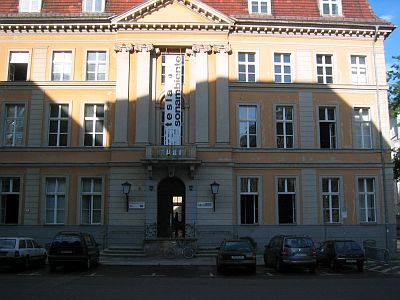
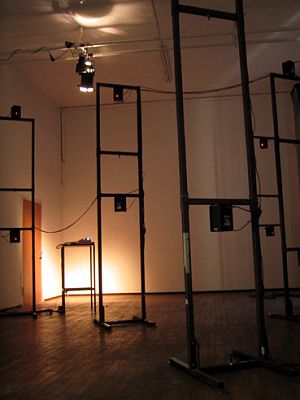
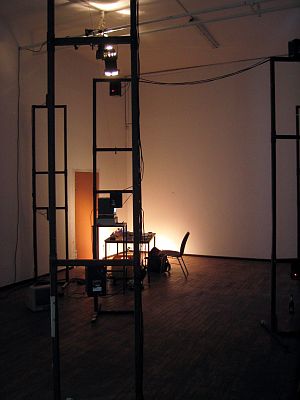
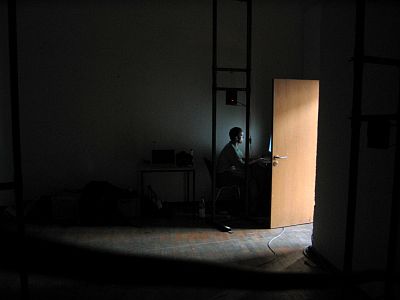
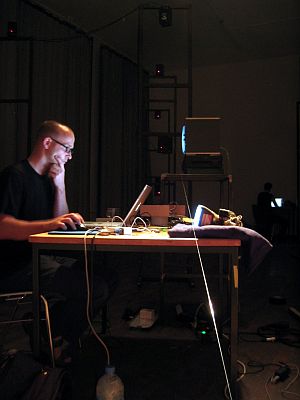
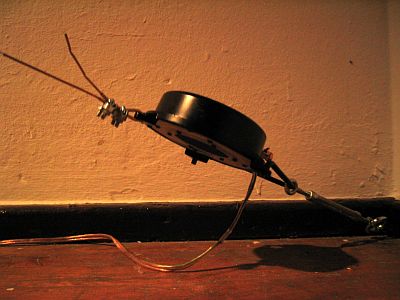
The spatialization setup of the sound had to be reworked. The video projection image was replaced by a mis-en-scène of the string itself, for which Ludger used a CRT stroboscope. Due to the stroboscope-like periodic light impulses emitted by the tube, pictures of interference are perceivable, revealing the string vibration in a slow-motion view.
The installation in Tesla was kindly supported by the SeaM Weimar and the Electronic Studio of the TU Berlin.